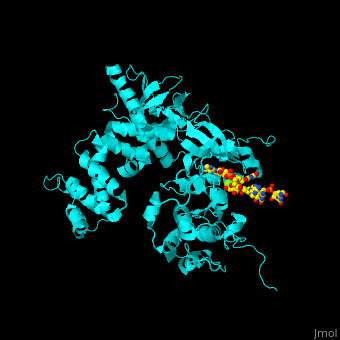Beta adrenergic receptor kinase (BARK) is an intracellular serine/threonine kinase. BARK is activated by protein kinase A. BARK phosphorylates the β adregenic receptor (BAR) when it is occupied by the agonist thus causing its desensitization. BARK belongs to the family of G protein-coupled receptor kinase (GRK). [1] (PDB code 3uzt).[2]
3D Structures of β adrenergic receptor kinase
Updated on 15-November-2015
1ym7 – bBARK1 (mutant) - bovine
4pnk, 3cik – hBARK1 + guanine-nucleotide binding protein G β,γ subunits – human
4mk0, 3v5w – hBARK1 + guanine-nucleotide binding protein G β,γ subunits + paroxetine derivative
3uzs – hBARK1 (mutant) + guanine-nucleotide binding protein G β,γ subunits + RNA
3uzt – hBARK1 (mutant) + RNA
3psc – hBARK1 (mutant) + guanine-nucleotide binding protein G β,γ subunits
3krw, 3krx – hBARK1 + guanine-nucleotide binding protein G β,γ subunits + inhibitor
3pvu, 3pvw – bBARK1 (mutant) + guanine-nucleotide binding protein G β,γ subunits + inhibitor
2bcj – bBARK1 (mutant) + guanine-nucleotide binding protein G α,β,γ subunits
1omw – bBARK1 (mutant) + guanine-nucleotide binding protein G β,γ subunits

